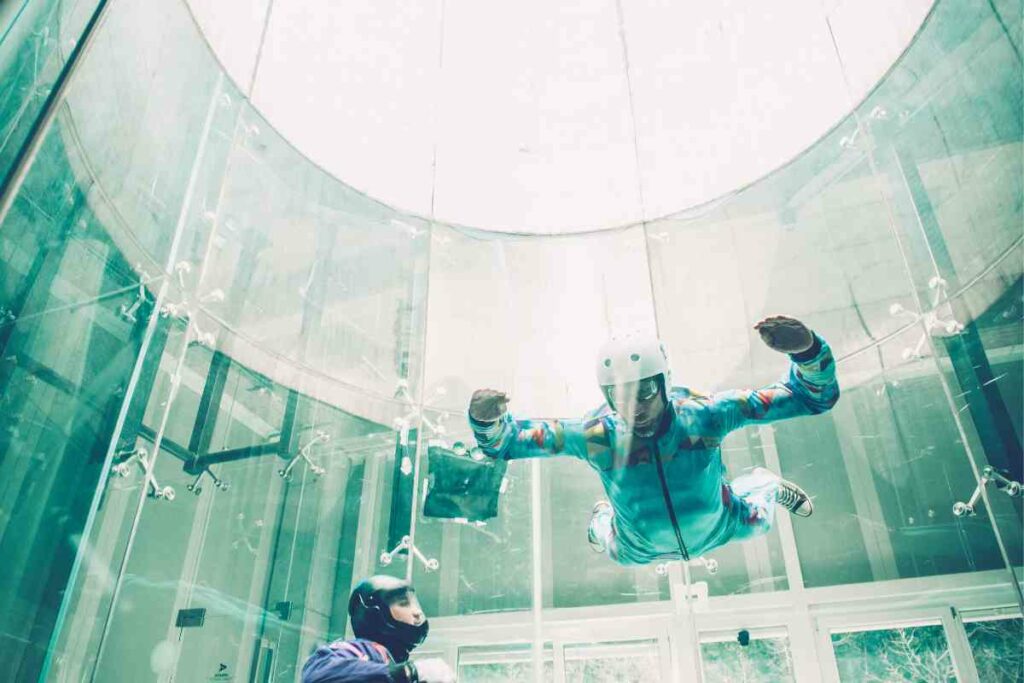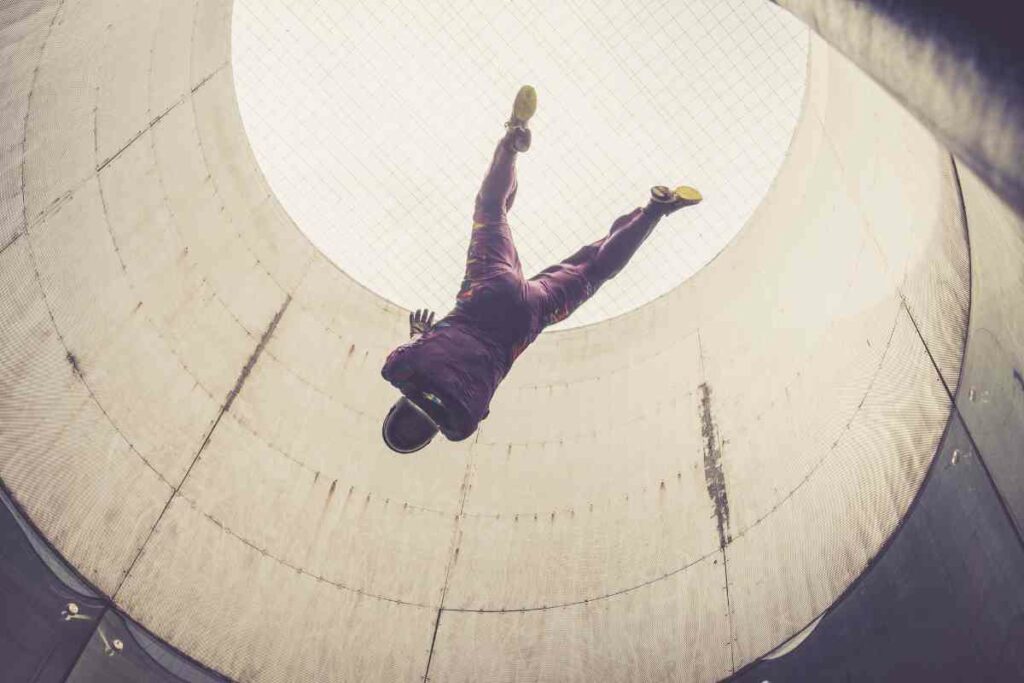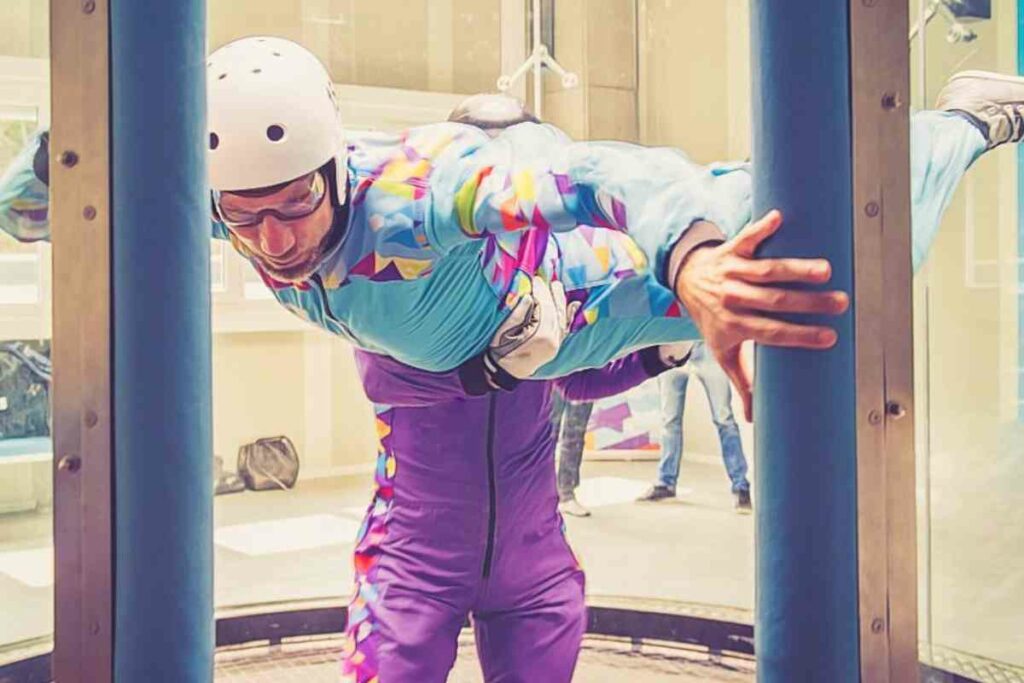Are you afraid of heights but still want to experience the thrill of skydiving? Believe it or not, indoor skydiving is perfect for those who fear being high up in the air.
With a wind tunnel that simulates freefall conditions, you can feel what it’s like to fly without having to brave altitudes that make your palms sweat.
Read on to find out how to manage and even overcome the fear of heights with indoor skydiving.
Can You Indoor Skydive If You Have a Fear of Heights?

Sure, the idea of being suspended in mid-air might sound scary at first, but indoor skydiving is different from regular skydiving because there’s no free-fall and you’re not as high off the ground.
Read before you go – Can You Indoor Skydive If You Have a Medical Condition?
The wind tunnel simulates the sensation of free-falling without actually jumping out of a plane.
It feels like floating on air while being supported by professional instructors who are always watching over your safety.
You’ll be equipped with special gear such as:
- Goggles
- Earplugs
- Helmet
- Neck buff
- Rash guards
- Knee and elbow pads
- Jumpsuit
- Shoes
Of course, everyone has their own level of comfort when it comes to heights so it’s important to make sure this activity is something you’re genuinely interested in trying out.
Puzzled? – How High Do You Go During Indoor Skydiving?
But once inside the wind tunnel, adrenaline takes over your body and all those fears seem to dissipate into thin air!
Indoor skydiving can be an exhilarating way to conquer your fear or simply try something new outside your comfort zone.
So don’t let acrophobia hold you back! With proper preparation and guidance from professional trainers, even someone scared stiff at great peaks can experience what it’s like to fly for a moment.
Benefits of Indoor Skydiving For Those With Fear of Heights

Overcoming Fear of Heights
Indoor skydiving is a perfect way to overcome the fear of heights as it simulates all the thrill and exhilaration without actually going high.
Building Confidence
The rush that comes with indoor skydiving helps build confidence, especially in individuals that have low self-esteem or drastic anxiety.
Safe Environment
Indoor skydiving has lesser risks when compared to traditional freefall outdoor activities making it a much safer option for those who are afraid of heights.
Enjoyable Experience
Many people describe indoor skydiving as enjoyable, fun, and sometimes even therapeutic which can help reduce stress levels too.
Skill Development
Not only does indoor diving provide an entertaining experience, but also enhances several skills such as body control critical thinking, and problem-solving abilities.
Curious to know more? Take a look at our Indoor Skydiving Beginners Guide and satisfy your curiosity!
Convenient Location
Since Indoor Sky Diving takes place indoors unlike outside locations where one may need transportation to remote places filled with risk-filled terrains like mountains or landscape changes; this makes Indoor Sky Dive ideal for anyone wary about traveling long distances outside their home town.
Steps to Approach Indoor Skydiving with Acrophobia
Acknowledge Your Fear
The first step to approaching indoor skydiving with acrophobia is accepting that you have a fear of heights. You must face your fear head-on and prepare yourself mentally for the experience.
Research Indoor Skydiving Facilities
The next step is to research different indoor skydiving facilities in your area and read reviews from customers who have tried it before. Find one with well-trained instructors, high safety standards, and good customer service.
Speak with the Instructors
When you arrive at the facility, speak with the instructional staff about your fears and concerns regarding indoor skydiving. They can provide valuable insights on how they will help make sure you feel comfortable throughout the process.
Know What To Expect During Training
Indoor Sky Diving training usually involves learning body positioning techniques through practice jumps inside a wind tunnel simulator before taking off into an outdoor parachute-free fall scenario later on during simulated freefall training exercises.
Focus On Breathing Techniques
Breath control may sound like common sense advice but practicing deep breathing when anxiety rises will tackle every nerve and boost their confidence in handling such situations much better than letting instincts run loose without regulation
Take It Slowly & Gradually Build Confidence
Take things slowly by starting out low and gradually building up your confidence as you get more comfortable with the experience. Don’t push yourself too hard or go beyond what feels safe and comfortable for you.
Trust In Your Training
Trust in the training that you received from the instructors, who are there to guide you through every step of the way. They have had tons of experience helping people like yourself face their fears head-on so trust them completely.
Final Thoughts ?
It is possible to indoor skydive even if you have a fear of heights. The controlled environment and supportive staff can help ease any anxieties.
If you’re willing to face your fears and try something new, it may just be the adrenaline rush you didn’t know you needed.







